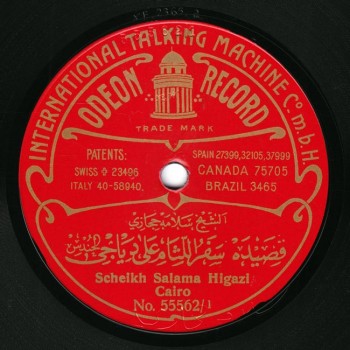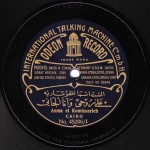 The Arab Music Archiving and Research foundation (AMAR), in collaboration with the Sharjah Art Foundation (SAF), presents “Sama‘ ”.
The Arab Music Archiving and Research foundation (AMAR), in collaboration with the Sharjah Art Foundation (SAF), presents “Sama‘ ”.
“Sama‘ ” discusses our musical heritage through comparison and analysis…
A concept by Mustafa Said.
Dear listeners,
Welcome to a new episode of “Sama‘ ”.
Today, instead of being hosts, we will be guests in the home of our permanent guest Frédéric Lagrange. What would you like to talk to us about, Sir?
Today, we will be talking, in riddles, about “Safar al-lithām ‘ala dayāj al-ḥundusi” that was recorded in 1909, 1910, or 1911. Let us call it a song even though it is a qaṣīda ‘ala al-waḥda.
Imagine that a record with such a title was successful one hundred years ago!
People bought it!
They did, and it was successful! Today, people would wonder what a record with a title like “Safar al-lithām ‘ala dayāj al-ḥundusi” was doing on the market.
Today, listeners would hit us.
Today, such words would scare away any listener.
Furthermore, “Safar al-lithām ‘ala dayāj al-ḥundusi” may be among the most difficult musical pieces recorded in the early 20th century to be accepted by contemporary listeners, because anyone who is not used to early 20th century music might see this piece recorded by Sheikh Salāma Higāzī as the peak of tediousness and monotonousness, a never-ending repetition of the same melodic phrase throughout the duration of the two record-sides.
Whereas to me the disc is full of ṭarab. I could listen to it in loop for a whole day, discovering every time a new dazzling and wondrous version of the phrase.
So our riddle today is Sheikh Salāma Ḥigāzī’s “Safar al-lithām ‘ala dayāj al-ḥundusi”.
Exactly.
The first riddle lies in the meaning of the lyrics: we will read the qaṣīda to the bayyātī –lyricist unknown– most probably created in the Mamluk or in the Ottoman era. Note the intertextuality with the Kuran text, specifically with Sūrat al-Takwīr.
The qaṣīda is as follows:
“Safar al-lithām ‘ala dayāj al-ḥundusi
Fa-aḍā’ al-ṣubḥu jabīnihi bi-tanaffusī”
The idea is taken from qaṣīda like Ibn al-Fāriḍ’s qaṣīda:
Removing the veil shows the beautiful girl’s jet black hair and sparkling white teeth, making her smile look like a morning sunrise… the same as in Sūrat al-Takwīr.
“Safar al-lithām ‘ala dayāj al-ḥundusi” means that removing the “lithām” unveiled intense blackness/darkness, i.e, the beloved’s black hair;
“Fa-aḍā’ al-ṣubḥu jabīnihi bi-tanaffusī”, i.e. the morning lit up her forehead. –As usual, the lyrics are in the masculine form even though they are dedicated to a woman–. So, the morning lit up her forehead in a breath … implying that he saw the unveiled face of his beloved.
The second verse:
“Yaḥmī wa-yaḥrusu in tanā‘asa jafnuhu
Ward al-khudūdi min al-suqāti al-lummasi”
These words must also be explained:
The “lithām”, i.e. the veil, protects the beloved’s rosy cheeks when her eyelids are sleepy –this is a current image in classic Arab poetry implying that one is more attractive when she looks sleepy, i.e. when her eyelids cover her eyes. The veil protects her (her face is compared to a garden) from the “suqāt” (those who water the garden), i.e. those who wish to touch her. So the general idea is that the veil keeps those who wish to inebriate his beloved from touching and defiling her.
Mortal jealousy.
Exactly… mortal jealousy as in Sheikh Salāma Ḥigāzī’s plays.
“ ‘An qaddihi al-mayyās fa-li-yuḥma al-naqa”, i.e. protect the purity of her moving/dancing body;
“Wa-‘an al-liḥāẓi, sal al-jawārī al-kunnasi”, another intertextuality with Sūrat al-Takwīr. In the dominant interpretation of the Holy Kuran, “al-jawārī al-kunnasi” are the stars. I.e. ask the stars about the eyes of the beloved;
“Da‘ mā yuqāl ‘an al-asinnati w-al-ẓibā w-aḥdhar muḥārabat al-‘uyūn al-nu‘‘asi”, i.e. ignore what is said about the weapons and about the deer that usually flee from hunters, and do not try to fight against sleepy eyes (another hint at the beloved’s sleepy eyes that make her more attractive).
I wonder if listeners at the time understood the lyrics, or if they only enjoyed listening to the beautiful words and never tried to solve the riddles. The qaṣīda is not very difficult to understand, yet it requires some explanation and necessitates listeners who have read qaṣīda from this period and are used to these similes and images present in almost all the period’s love poetry.
What do you think? Do you think an ordinary listener –what is an “ordinary listener”?– would actually understand the meaning of these lyrics?
I think that the period’s “ordinary listeners” adopted the theory of ‘Abduh al-Ḥāmūlī stating that Sheikh Salāma Ḥigāzī would have created ṭarab even if he sang “Rayān yā figl”… They accepted absolute drama/tragedy performed by Sheikh Salāma Ḥigāzī’s when they did not accept it from others.
Of course.
Moreover, all the tragedies were in literary Arabic –a very difficult language –. In fact, even Sheikh Najīb al-Ḥaddād’s language was difficult.
So the lyrics of “Safar al-lithām ‘ala dayāj al-ḥundusi” are very difficult to understand, yet the qaṣīda achieved great success in the early 20th century, in 1909, 1910, or 1911. The point is: why did I choose this qaṣīda?
The second riddle lies in Sheikh Salāma Ḥigāzī’s perspective on the qaṣīda ‘ala al-waḥda that was intrinsically different from Sheikh Yūsuf al-Manyalāwī’s or ‘Abd al-Ḥayy Ḥilmī’s. First, the dancing, i.e. the cheerful interpretation of music that appears from the start, from the dūlāb and the ‘awādhil.
Let us listen to Salāma Ḥigāzī’s bayyātī version of dūlāb al-‘awādhil…
(♩)
Note the strong presence of the riqq’s sound creating ṭarab and a dancing atmosphere. I do not think this is in any way related to Odeon’s recording technique.
I doubt it.
I doubt it too… because others besides Sheikh Salāma Ḥigāzī recorded with Odeon….
… at the time, including ‘Abd al-Ḥayy Ḥilmī.
Moreover, Sheikh Salāma Ḥigāzī presented this same type of interpretation with the dawr he recorded during the same campaign.
Exactly. Sheikh Salāma Ḥigāzī clearly wanted the percussionist to play close to the megaphone. He wished the percussions to be clearly heard, and thus to convey this dancing spirit to his performance of qaṣīda, of dawr, and even of ‘awādhil.
The second notable element in the interpretation of the qaṣīda is the structure of the qaṣīda ‘ala al-waḥda: in the early 20th century, almost all muṭrib sang to the bayyātī. They started to the bayyātī aspect then modulated to a nahāwand aspect, to a ‘ajam aspect, or to a different bayyātī aspect –a jawāb, i.e. at the ḥusaynī –when the bayyātī is at the ḥusaynī, the rāst is at the nawā.
We will hear some rāst and some nahāwand.
And maybe some sikāh / awj.
Exactly… a few modulations until we go back to the bayyātī in the end.
…A known pattern and a known system with a few different elements. Sheikh Salāma Ḥigāzī chose a different route opposing the traditional one: he almost did not go outside dūlāb al-‘awādhil, which explains why those who are not used to such an interpretation or to such music disliked this particular recording of “Safar al-lithām ‘ala dayāj al-ḥundusi” that is a caricature of Sheikh Salāma Ḥigāzī’s performance of qaṣīda: what we can hear from “Safar al-lithām” to “al-‘uyūn al-nu‘‘as” –by the way these lyrics do not make me sleepy, even though they might bore others–, i.e. the qaṣīda from start to finish, is a repetition of dūlāb al-‘awādhil with brilliant variations applied to the rhythm.
It is strange to find qaṣīda to the baḥr kāmil and the ‘awādhil melody.
No, Sir. There are qaṣīda ‘ala al-waḥda to the baḥr kāmil including Umm Kulthūm’s “Afdīhi in ḥafiẓa al-hawa”, “Safar al-lithām”, “In kāna Yūsuf li-al-jamāli da‘ākum” also by Sheikh Salāma Ḥigāzī, Yūsuf al-Manyalāwī’s “Dayya‘ti ‘ahda fata”, and even “Ghayrī ‘ala al-silwān qādir”.
I meant that most were to the baḥr ṭawīl.
Because most qaṣīda are to the baḥr ṭawīl.
True.
While there are also qaṣīda to the baḥr basīṭ, such as “Yā Zaynabu al-ḥasnā’ ” to the sari‘ and “Ḥāmil al-hawa ta‘ib”, muqṭaḍab.
I am talking about the distribution of the ‘awādhil: in “Ḥāmil al-hawa ta‘ib” or in “Yā Zaynabu al-ḥasnā’ ” for example, the melody of the ‘awādhil is not clear, whereas it is very well-defined in “Safar al-lithām ‘ala dayāj al-ḥundusi” including clear scansion and variations.
The point is that no syllable is uttered on the dum: a dum followed by “Afdīh in”; a dum followed by “Safar al-lithā”; a dum followed by “In kāna yū”; and a dum followed by “Dayya‘ti ‘ah”. There is one exception, one variation: in “ghayrī”, “ghay” is on the dum.
Sheikh Salāma Ḥigāzī sometimes performs a variation and sings “safar” on the dum.
In baḥr such as the baḥr kāmil, the performer usually starts after the dum, yet he may do otherwise. Here lies the genius in the performance of “Safar al-lithām”.
In this qaṣīda, Salāma Ḥigāzī plays with the rhythm more than he does with the melody. His performance is a lesson in scansion.
Indeed. The point is that there is no variation in the maqām and that the pattern of the bayyātī –either nawā or ḥusaynī– is followed.
He achieved an entertaining performance while abiding by the maqām pattern thanks to his variations applied to the affixing of the ‘arūḍ onto the rhythm.
Scanning ‘arūḍ onto the rhythm.
Indeed, scanning ‘arūḍ onto the rhythm in a different and creative manner in each phrase, creating a brilliant qaṣīda from start to finish.
Do you think that Sheikh Salāma Ḥigāzī sang such qaṣīda on stage in his musicals?
Two types of recordings of Sheikh Salāma Ḥigāzī’s qaṣīda have reached us: the theatre stage takht music –with the characteristics of the takht applied to the stage–; and the purely takht pieces –mostly, this qaṣīda and most qaṣīda ‘ala al-waḥda are purely takht pieces.
So you think that he preferred to sing qaṣīda mursala rather than qaṣīda ‘ala al-waḥda on stage.
Yes, either mursal or muwaqqa‘ –not muwaqqa‘ ‘ala al-waḥda– such as muwashshaḥ and composed pieces like the “Salāmāt” for example.
He may have sung qaṣīda ‘ala al-waḥda in between faṣl, but I do not think that he incorporated qaṣīda ‘ala al-waḥda in his plays. Muḥammad Fāḍil categorized these qaṣīda in the first chapter of his book: Sheikh Salāma Ḥigāzī started his inshād journey with qaṣīda abiding by a measure and composed ‘ala al-waḥda, and with these maqāṭī‘ specific to inshād and dhikr. Thus, his inshād qaṣīda were taken from inshād and from dhikr to the takht. He may have sung them in between faṣl, but they are not the same as the qaṣīda specifically created for plays.
Beautiful.
Let us conclude today’s episode with this very cheerful qaṣīda recorded on two sides of an Odeon record. It is the last recording of Sheikh Salāma Ḥigāzī in our possession.
According to the matrix number.
According to the matrix number, it is indeed the last recording of Sheikh Salāma Ḥigāzī.
It seems that he wished to be considered as a takht muṭrib, not only as a musical play muṭrib. This was his last recording with Odeon. It is said that Gramophone wanted to record his voice, but that they were afraid of his sponsorship contract with Odeon. Is this true?
It is.
We end our episode with “Safar al-lithām ‘ala dayāj al-ḥundusi” performed by Sheikh Salāma Ḥigāzī accompanied by Sāmī al-Shawwā, and Muḥammad Ibrāhīm… the percussionists are unknown…
(♩)
Dear listeners, we have reached the end of today’s episode of “Sama‘ ”.
We will meet again in a new episode.
We thank Prof. Frédéric Lagrange
“Sama‘ ” was presented to you by AMAR.
- 221 – Zakariyya Ahmed – 12 (1/9/2022)
- 220 – Zakariyya Ahmed – 11 (1/9/2022)
- 219 – Zakariyya Ahmed – 10 (11/25/2021)
- 218 – Zakariyya Ahmed – 9 (10/26/2021)
- 217 – Zakariyya Ahmed – 8 (9/24/2021)
- 216 – Zakariyya Ahmed – 7 (9/4/2021)
- 215 – Zakariyya Ahmed – 6 (8/28/2021)
- 214 – Zakariyya Ahmed – 5 (8/6/2021)
- 213 – Zakariyya Ahmed – 4 (6/26/2021)
- 212 – Zakariyya Ahmed – 3 (5/27/2021)
- 211 – Zakariyya Ahmed – 2 (5/1/2021)
- 210 – Zakariyya Ahmed – 1 (4/28/2021)
- 209 – W-al-Lāhi lā astaṭī‘u ṣaddak 2 (4/6/2017)
- 208 – W-al-Lāhi lā astaṭī‘u ṣaddak 1 (3/30/2017)
- 207 – Bashraf qarah baṭāq 7 (3/23/2017)



